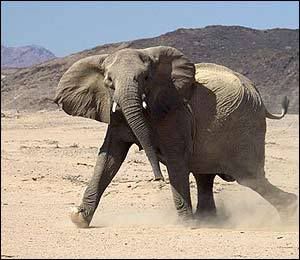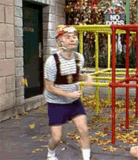
By Laura Clout
They say there is a fine line between genius and madness.
And perhaps when Warren Thomas, the director of Lincoln Park Zoo in Oklahoma City took aim at an elephant with a giant syringe full of LSD he thought he was on the brink of making an important scientific discovery.
But an hour later, as his target, a 14-year-old male called Tusko keeled over stone dead, perhaps Mr Thomas might have accepted he had crossed the line into lunacy.
The study, carried out in 1962, now tops a list of the most bizarre and outrageous experiments carried out in the name of science.
Featured in this week’s New Scientist magazine, the newly-published book Elephants On Acid and Other Bizarre Experiments includes other nightmarish tales of two-headed dogs, vomit-drinking doctors and dismembered turkeys.
The book’s author Alex Boese says all the experiments were performed by single-minded, but hard-working scientists who were not prepared to accept common sense explanations of how the world works.
“I scoured scientific archives searching for the most bizarre experiments of all time — the kind that are mind-twistingly, jaw-droppingly strange... the kind that make you wonder, “How did anyone ever conceive of doing such a thing?” he said.
The Top Ten wackiest experiments of all time:
1) Elephants on Acid
When Tusko was hit with 297 milligrams of LSD - about 3,000 times the typical human dose - the idea was to determine whether it would trigger a temporary form of madness called musth, in which male elephants become aggressive.
But when the shocked creature died, an hour after trumpeting around its pen, the scientists claimed in their defence that they had taken the drug themselves and suggested the drug could be used to cull problem herds.
2) Prepare for crash landing
In another study in the 1960s, a group of 10 soldiers were on a training flight when the pilot announced over the intercom: “We have an emergency. An engine has stalled and the landing gear is not yet functioning. I’m going to attempt to ditch in the ocean.”
As the soldiers faced what appeared to be their final moments, they were handed insurance forms to fill in - ostensibly to exempt the Army from financial liability for their deaths.
After they completed the paperwork - the soldiers were informed that their minutes of terror had been engineered as part of an experiment to see whether extreme stress affects cognitive ability.
An attempt to repeat the experiment was foiled by one disgruntled guinea-pig, who left a note on a sick bag to warn other colleagues.
3) Frankenstein dogs
In 1954, Soviet surgeon Vladimir Demikhov revealed a two-headed dog, created by grafting the head, shoulders and front legs of a puppy to the neck of an adult German Shepherd.
The puppy would lap milk, even though it dribbled from the stump of it’s partially attached head, and occasionally the two heads would fight with the puppy biting the other head on the ear.
The ill-fated creature lived for less than a month, but Demikhov created 19 others over the next 15 years and his gruesome study is credited with paving the way for human heart transplant surgery.
4) Titillating turkeys
Martin Schein and Edgar Hale appeared to prove that some males really will try it on with anything with a pulse.
Studying the sexual behaviour of turkeys in the 1960s, they took a lifelike model of a female bird and progressively dismantled it until the males lost interest.
The pair, from Pennsylvania State University found that the male turkeys still remained turned on when all that was left was a head on a stick.
5) Vomit-drinking doctor
Convinced that yellow fever was not an infectious disease, trainee doctor Stubbins Ffirth set out to test his hypothesis on himself.
First he rubbed fresh vomit from an infected patient into a cut on his arm.
When he failed to fall ill, he dribbled the liquid into his eyes, breathed in the vomit vapour, and finally drank it.
The doctor remained perfectly healthy, but not because yellow fever is not infectious.
Later studies revealed the disease is passed on by being injected directly into the blood stream - usually from the bite of an infected mosquito.
6) Professor Tickle
In 1933, Clarence Leuba, a professor of psychology Yellow Springs, Ohio set out find out whether laughter is an innate response to being tickled, or whether it is learned from the responses of others.
He ordered that no one could laugh while tickling his newborn son, and donned a mask to hide his own reactions during tickling sessions with the little boy.
Seven months later, the baby was screaming with laughter when being tickled, and three years later his younger sister reacted in a similar fashion.
Leuba concluded laughter is a spontaneous reaction to being tickled.
7) Nail-biting therapy
Lawrence LeShan, a researcher from Virginia wondered whether subliminal messaging could break bad habits.
He stood in a cabin where a group of boys were sleeping and repeated over and over “my nails taste terribly bitter” - to see if he could stop their chronic nail-biting.
The experiment appeared to work as by the end of the summer, 40 per cent of the youngsters had broken the habit.
However, doubt has since been cast on whether the boys were actually asleep throughout.
8) Raising the dead
In the 1930s, Robert Cornish at the University of California attempted to bring dead animals back to life by placing the corpses on a seesaw.
Using a series of fox terriers called Lazarus, the biologist also injected the bodies with adrenaline and anti-coagulants.
The few that did momentarily stir back to life suffered blindness and brain damage, but that did not stop a death row prisoner from volunteering as a human guinea-pig.
The state of California however, refused Cornish permission.
9) Eyes wide open
In 1960, Ian Oswald of the University of Edinburgh sought to discover whether people really can sleep through anything.
He taped open volunteers’ eyes, placed flashing lights 50cm in front of them, and exposed them to electric shocks and very loud music.
All three subjects nevertheless fell asleep within just 12 minutes.
Oswald concluded that the regular and monotonous rhythm of the stimuli allowed them to doze off.
10) Face of disgust
In the hope of pinpointing a universal facial expressions, psychologist Carney Landis subjected volunteers to a series of bizarre experiences.
After drawing lines on their faces with burnt cork to allow him to track the movement of their muscles, he photographed their expressions as they were asked to smell ammonia, listen to jazz, look at pornography or place their hands into a bucket of frogs.
Finally each was persuaded to decapitate a live rat, resulting in pictures Mr Boese describes as looking like “members of a strange cult preparing to offer a sacrifice to the Great God of the Experiment”.







